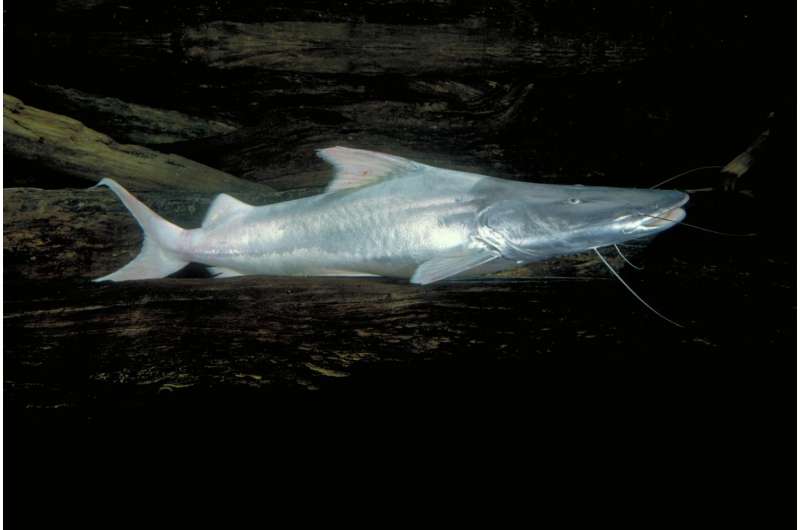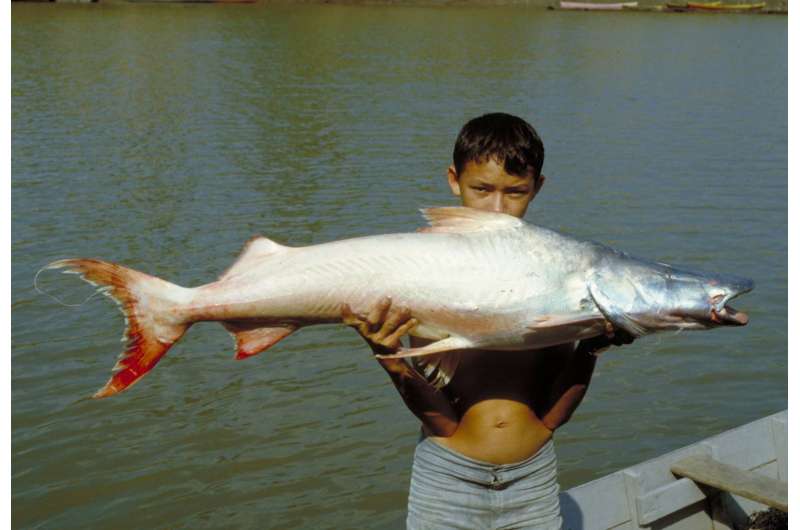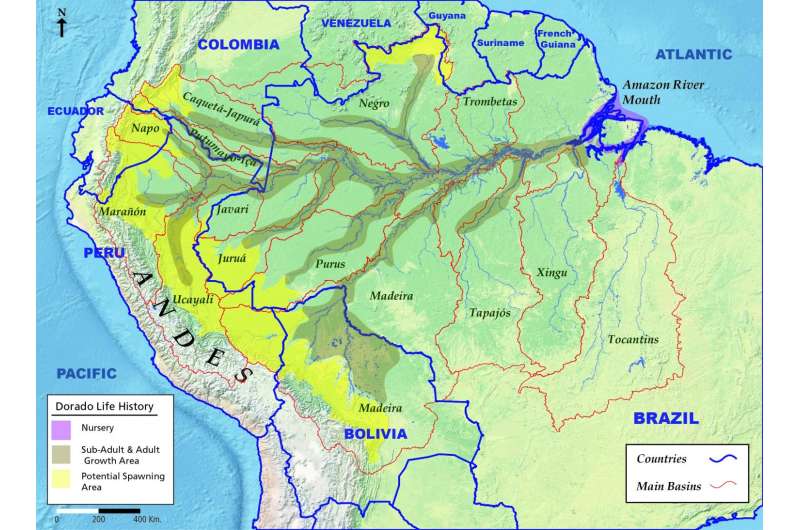An image of a live dorado catfish in a tank. A newly published study on the dorado and other "goliath" catfish has revealed that the dorado's full life-cycle migration stretches more than 7,200 miles in length. Credit: Michael Goulding/WCS.
An international team of scientists has confirmed that the dorado catfish (Brachyplatystoma rousseauxii) of the Amazon River basin holds the record for the world's longest exclusively freshwater fish migration, an epic life-cycle journey stretching nearly the entire width of the South America continent.
The finding, published today in the journal Scientific Reports-Nature, is an output of WCS's Amazon Waters Initiative, sponsored by the Science for Nature and People Partnership (SNAPP) led by WCS (Wildlife Conservation Society), The Nature Conservancy (TNC) and the National Center for Ecological Analysis and Synthesis (NCEAS).
The study reveals the amazing life histories of the dorado and three other "goliath" catfish species that spawn in the western headwaters of the Amazon. The journey of the dorado catfish specifically begins with adults and pre-adults traveling thousands of kilometers upriver from the Amazon River estuary to spawning areas in or near the Andes Mountains. The breeding fish never return to their nursery areas, but the newborn catfish do, migrating thousands of kilometers in the opposite direction to complete the cycle. The dorado catfish was found to have a life-cycle migration of approximately 11,600 kilometers (more than 7,200 miles).
Growing up to nearly 6 feet in length, the dorado catfish is sometimes called the gilded catfish due to its silver and gold skin with no scales. The dorado and the other three closely related species are widely distributed in the Amazon River basin and are among the most important commercialized species. The paper's authors warn that looming development plans for proposed dams, mining operations, and deforestation—especially in the Amazon's headwaters where these fish spawn—could imperil these long-distance migrants and the fishing industries that rely on them.
Growing up to six feet in length, the dorado catfish is sometimes called the gilded catfish due to its silver and gold skin. Credit: Michael Goulding/WCS.
"This is the first time that scientific research has linked the full range of these fish species, some of which stretch from the Andes to the Amazon River estuary abutting the Atlantic Ocean," said lead author Ronaldo Barthem of Museu Paraense Emílio Goeldi of Brazil. "These findings can now inform effective management strategies for these fish, some of which are important for fishing industries in the region."
"One of the biggest threats to the dorado catfish and other fish species is headwater infrastructure development in the Andes that could heavily impact the spawning grounds of the world's longest freshwater migrants," said WCS aquatic scientist Michael Goulding, a co-author on the study.
Whereas the journeys of fish such as salmon and eels are well known, the migratory movements of goliath catfish have been less understood and poorly documented, although it was suspected that goliath catfish make the longest freshwater fish migrations in the world.
A map of dorado's life-cycle migration range. Credit: WCS.
To confirm this hypothesis, the research team mapped the long-distance movements of four goliath catfish species (Brachyplatystoma rousseauxii, B. platynemum, B. juruense, and B. vaillantii) using information on the presence of adult fish, juveniles, and larvae across the Amazon. The scientists also statistically analyzed the downstream migrations of juvenile fish and larvae from the headwaters of the Amazon's tributaries to the nurseries.
The study results revealed that adult dorado catfish traveling upstream from the Amazon estuary may take as long as 1-2 years to reach their spawning grounds in or near the Andes. The scientists also confirmed that at least two other goliath catfish species (B. platynemum, and B. juruense) spawn near or in the Andean foothills, and suspect that there are other species as well.
The researchers added that the newly published goliath catfish study will serve as a foundation for later research. Tagging experiments and analyses of isotopes in calcium deposits in the inner ear of fish can both be used to study the migratory pathways of goliath catfish and the seasonal timing of those movements.
"Many questions remain about these incredible fish, such as why they travel so far to reproduce and do they return to place of birth to spawn," said Goulding. "Now we have a baseline that will help direct the trajectory of future research and conservation efforts."
More information: Ronaldo B. Barthem et al, Goliath catfish spawning in the far western Amazon confirmed by the distribution of mature adults, drifting larvae and migrating juveniles, Scientific Reports (2017). DOI: 10.1038/srep41784
Journal information: Scientific Reports
Provided by Wildlife Conservation Society

























